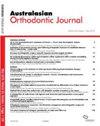Comparison of the cytotoxicity of 3D-printed aligners using different post-curing procedures: an in vitro study
IF 0.9
4区 医学
Q4 DENTISTRY, ORAL SURGERY & MEDICINE
引用次数: 1
Abstract
Abstract Objective Three-dimensional (3D) printing technology represents a novel method for manufacturing aligners. The aim of the present study was to assess the in-vitro cytotoxicity of 3D-printed aligners using different post-polymerisation conditions. Materials Aligners were printed using the same 3D-print resin (TC-85DAC, Graphy, Seoul, Korea) and printer (AccuFab-L4D, Shining 3D Tech. Co., Hangzhou, China), followed by different post-curing procedures. Six aligners were post-polymerised for 14 min using the Tera Harz Cure and a nitrogen generator curing machine (THC2, Graphy, Seoul, Korea) (P1). A further six aligners were post-cured for 30 min on each side using the Form Cure machine (FormLabs Inc, Somerville, USA) (P2). The aligners were cut into smaller specimens (2 mm×2 mm) and sterilised at 121°C. The specimens were placed in 96-well plates containing Dulbecco’s Modified Eagle’s Medium (DMEM) at 37° for 7 or 14 days. The viability of MC3T3E-1 pre-osteoblasts cultured with DMEM was evaluated using the 3-(4,5-dimethylthiazol-2-yl)-2,5-diphenyltetrazolium bromide (MTT) assay. The optical density of each cell culture was measured to assess cell viability, following which the data were statistically analysed using two-way and one-way ANOVA (α = 0.05). Results The comparison of cytotoxicity revealed statistically significant differences between post-curing procedures and MTT timings (P < 0.001). After 7 and 14 days, the cell viability of P2 was significantly reduced compared to P1 and the control groups (P < 0.001), while P1 showed no significant differences compared to the controls. Overall, P2 post-curing exhibited moderate cytotoxicity, while P1 post-polymerisation was highly biocompatible. Conclusions Different post-curing procedures may affect the in-vitro cytotoxicity of 3D-printed aligners. Clinicians should adhere to the manufacturer’s recommendations when using 3D-print resin.使用不同后固化程序的3D打印校准器的细胞毒性比较:一项体外研究
摘要目的三维打印技术代表了一种制造对准器的新方法。本研究的目的是评估使用不同聚合后条件的3D打印对准器的体外细胞毒性。使用相同的3D打印树脂(TC-85DAC,Graphy,Seoul,Korea)和打印机(AccuFab-L4D,Shining 3D Tech.Co.,Hangzhou,China)打印材料对准器,然后进行不同的后固化程序。使用Tera Harz Cure和氮气发生器固化机(THC2,Graphy,Seoul,Korea)对六个对准器进行后聚合14分钟(P1)。使用Form Cure机器(FormLabs Inc,Somerville,USA)在每侧对另外六个对准器进行30分钟的后固化(P2)。对准器被切成更小的样本(2 mm×2 mm),并在121°C下消毒。将样品放置在含有Dulbecco改良Eagle培养基(DMEM)的96孔板中,温度为37°,持续7或14天。用3-(4,5-二甲基噻唑-2-基)-2,5-二苯基溴化四唑(MTT)法评估用DMEM培养的MC3T3E-1预成骨细胞的活力。测量每个细胞培养物的光密度以评估细胞活力,然后使用双向和单向ANOVA对数据进行统计学分析(α=0.05)。结果细胞毒性比较显示,治疗后程序和MTT时间之间存在统计学显著差异(P<0.001)。7天和14天后,P2的细胞活力与P1和对照组相比显著降低(P<0.001),而P1与对照组相比没有显著差异。总体而言,P2固化后表现出中等的细胞毒性,而P1聚合后具有高度的生物相容性。结论不同的后固化程序可能会影响3D打印对准器的体外细胞毒性。临床医生在使用3D打印树脂时应遵守制造商的建议。
本文章由计算机程序翻译,如有差异,请以英文原文为准。
求助全文
约1分钟内获得全文
求助全文
来源期刊

Australasian Orthodontic Journal
Dentistry-Orthodontics
CiteScore
0.80
自引率
25.00%
发文量
24
期刊介绍:
The Australasian Orthodontic Journal (AOJ) is the official scientific publication of the Australian Society of Orthodontists.
Previously titled the Australian Orthodontic Journal, the name of the publication was changed in 2017 to provide the region with additional representation because of a substantial increase in the number of submitted overseas'' manuscripts. The volume and issue numbers continue in sequence and only the ISSN numbers have been updated.
The AOJ publishes original research papers, clinical reports, book reviews, abstracts from other journals, and other material which is of interest to orthodontists and is in the interest of their continuing education. It is published twice a year in November and May.
The AOJ is indexed and abstracted by Science Citation Index Expanded (SciSearch) and Journal Citation Reports/Science Edition.
 求助内容:
求助内容: 应助结果提醒方式:
应助结果提醒方式:


